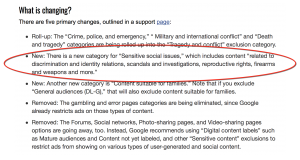
When J.Crew emailed the author with 50% off on one day, 80% off on another, he wondered: Was this dynamic pricing or a force beyond data?
Check your inbox right now, and you’ll likely have an email about a big sale waiting for you. Chances are, you received one the day before, from the same place, about a different sale.
I should know: Over about a week earlier this month, J.Crew’s outlet, J.Crew Factory, sent me near-daily updates on their wildly varying prices: 50% off everything plus an extra 10% off (different from 60% off, I guess?); new arrivals 40% off; then, two days later, new arrivals 40% – 60% off; then, a flash sale had erupted, resulting in “an extra” 30% plus free shipping, and on and on.
How can the same sweater be so many different prices in such a short time?
It’s tempting to assume that you’re watching a version of one of 2014’s biggest e-commerce revolutions: dynamic pricing. It’s true that companies from Amazon to Walmart to Best Buy have all aggressively moved into pricing that’s data-driven, responsive, and nimble enough to change in real time. Amazon, the leader in this kind of behavior, modifies the price of goods depending on your zip code, popular Google searches, competitor prices, and many other variables. Walmart’s recently pledged to match any price on Amazon, effectively yoking them to those same methods. A recent report by Internet Retailer magazine found that even Sears, one of America’s oldest retailers, is on board, changing prices up to four times a day on some of its items (Amazon changes them up to 10 times a day, the same report found).

But according to industry insiders and analysts, dynamic pricing, indeed any kind of data-intensive price modification, hasn’t been embraced by clothing retailers. A highly elastic industry that posted over $176 billion in sales in 2014, according to global information group the NPD Company, it’s nevertheless decided to largely sit out the dynamic pricing dance. Why are apparel retailers turned off by big data?
“Retail pricing is governed by a lot of really old, established principals,” says Sucharita Mulpuru, lead e-commerce retail analyst at Forrester Research. “There’s this whole pricing that’s like, ‘cost plus,’ which is basically, companies deciding: We’re going to make a 50% margin, and that’s it, regardless or whether your consumer’s willing to pay more for that.” Even if more retailers wanted to implement dynamic pricing, Mulpuru says, “most companies don’t even have the ability or the technology to execute it.”
Take, for instance, the 30 people who are right now sitting in the New York offices of the online retailer JackThreads figuring out how much their clothes should cost. This team—two dozen buyers and half a dozen planners—are making phone calls to the brands they sell, (everyone from Levi’s to Beats by Dre), negotiating price points, examining competitors, evaluating what their customer might be willing to pay, and thinking about how much over their own buying price they need to charge to cover all their costs. It’s not too different from how department stores have worked for nearly a century.
When I ask Michelle Cordeiro Grant, JackThreads’ VP of Commerce, if they would think about changing their prices more than once a day, she laughs. “We’re not managing our business like a quant experiment,” she says, “where we ebb and flow like the stock market. I know places like Amazon do things like, but we do not.”
So how do they work? “If we set the price of Selvedge jeans at $99, we believe that’s the right price for what we’re delivering to our consumer,” Grant says. “And then the consumer votes based on sales.” If it’s selling, it stays the same price, and if it’s not, they start to think about lowering the price. It’s a pretty simple picture, and it leaves out any analysis of searches, views, clickthroughs, or any of the other of the hundreds of data points the Internet offers a retailer like JackThreads.
Sometimes, this lack of careful examination can have unintended consequences. J.Crew Factory, for example, was actually offering higher prices on some items during Black Friday and Cyber Monday weekend, supposedly the most deeply discounted time of the year. J.Crew declined to comment on their pricing strategies, so I asked Mulpuru: Was this a scheme to increase their revenue, in hopes their customers wouldn’t notice?
“I don’t think that they’re that scientific about what they’re doing,” says Mulpuru. “I don’t think they do a lot of scientific evaluation about, is this the best price that we’ve ever given on this particular good?” Retailers make company-wide discount decisions, she says, without thinking about how that might impact every item. For instance, everything the company offers in stores and online might get marked to a blanket 50% off its original price, ignoring that some items were already far below 50% off their original price—those items will therefore become more expensive during a sale.
Clothing retailers have lots of other structural and emotional reasons to avoid dynamic pricing. One is pretty simple: They’re too nice. Or, put another way, they want to encourage a personal relationship between the consumer and their brand, and are worried that changing prices too much might seem flaky and weird.
“I’d hate for the customer to buy something for $100 and see it three hours later for $80,” says Grant. “I, as a consumer, would be really disappointed in that.”
So, if dynamic pricing isn’t behind all those sale emails, what is? Just old-fashioned trial and error, it seems. Retailers test sale terminology privately and publicly, and find that “percent off works better than dollar off for certain customers for certain promotions and then they run with that,” says Mulpuru. “Free shipping at certain thresholds generates certain kinds of behavior versus another type of free shipping offer.”
Not surprisingly, retailers are also just trying to offer the lowest price, especially on items already headed for clearance. And they’re doing it in ways their research shows will get a response. That seems to be as far as they’re willing to go with their data analysis. At least for now. But be sure to check back tomorrow.
(326)






